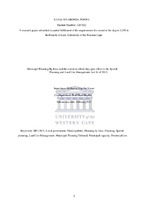| dc.contributor.advisor | De Visser, Jaap | |
| dc.contributor.author | Poswa, Xavia | |
| dc.date.accessioned | 2018-06-20T11:31:26Z | |
| dc.date.available | 2018-08-31T22:10:06Z | |
| dc.date.issued | 2017 | |
| dc.identifier.uri | http://hdl.handle.net/11394/6072 | |
| dc.description | Magister Legum - LLM (Public Law and Jurisprudence) | |
| dc.description.abstract | The spatial legacy created by the planning laws of the apartheid regime is still apparent in most cities
and towns across South Africa. The legacy of apartheid spatial planning reveals not only planning
which was undertaken along racial lines and inequality in the provision of infrastructure, amenities
and accessibility, but the distances between where the poor and the rich live further perpetuates that
inequality. Moreover, these planning laws also created a spatial pattern which resulted in the costs of
maintaining infrastructure to be very high and public transport difficult to provide and access.
Berrisford notes, "the roots to this legacy are complex and varied, but the regulatory frameworks
governing land tenure, development and use played a prominent role in creating problems now faced
by South African towns and cities". | |
| dc.language.iso | en | |
| dc.publisher | University of Western Cape | |
| dc.title | Municipal Planning By-laws and the extent to which they give effect to the Spatial
Planning and Land Use Management Act 16 of 2013. | |
| dc.rights.holder | University of Western Cape | |

